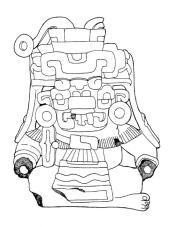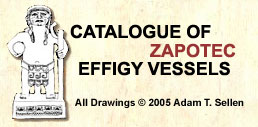| Key: SMI 198426 | | Actual Location: Smithsonian Institution, Washington D.C., United States. | | Collection: Martínez Gracida 1894; Lucio Smith; E.W. Nelson. Acquired by the SMI on 29 March 1899. | | Registration: Cat. 198427; Acc. # 34807 | | Provenance: Zaachila, Oaxaca. | | Measurements: 44 x 38 cm. | | Color: Dark grey clay | | Chronology: MA IIIB (Boos 1966b: 30); Peche 500 - 600 AD | | Click to view Chronology | | Reference: Martínez Gracida, Oaxacan Indians and their archaeological monuments, Vol. I, Ceramics, 1910, plate 81, unpublished work; Boos 1966b: 30, fig. 3.; Whitecotton 1977: 65. | | Comments: In September 1894 Martínez Gracida found this piece in a grave next to three other identical pieces. Soon after he sold all four objects: one to Luis Reynaud, two to Lucio Smith, and one to Eduard Seler along with the rest of his collection. Today there are two identical artefacts in the Smithsonian Institution but they are not complete (see also SMI 198427). The pieces in the Smithsonian come from Lucio Smith via E. W. Nelson. The artefact in the Peabody Museum (see PMAE 10609) arrived via the AMNH in 1929. This is the most complete artifact and was the urn purchased by Eduard Seler in 1895. The fourth piece, purchased by Luis Reynaud, ended up in the Bellon collection (see NMAI 180086). | | Glyphs: The epsilon glyph hanging from the ears. Glyph C in the headdress. | |
| | 
Click to view high resolution in a new window
select this image for review |
